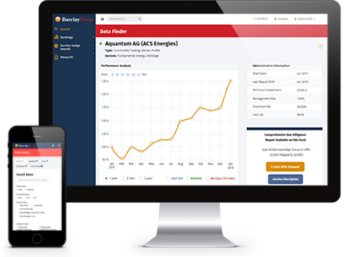By Alan R. Kaufman
Chief Investment Officer
Trilogy Capital Management
Princeton, New Jersey
Introduction:
In Search of the Perfect Alternative Investment Strategy
In the past five years interest has increased substantially in the use of hedge funds as diversifiers for traditional equity and fixed income portfolios. Recent weakness in global equity markets, and forecasts for significantly lower returns over the next several years are likely to accelerate this growth.
While the universe of hedge funds encompasses many different strategies, the underlying drivers of returns often share common characteristics. Seeking uncorrelated, low volatility, absolute returns, a large number of hedge funds are based on arbitrage type strategies. Empirical evidence indicates that this type of approach can yield equity-like returns with lower than equity market volatility. However, the inherent weakness of these strategies is their tendency to perform well in calm markets, and poorly in periods of market volatility - or periods of large 'event risk.' Examination of their pattern of returns indicates that arbitrage funds are generally short "volatility."
One common approach to mitigating this short volatility exposure in arbitrage-based hedge funds is to invest in a more diversified array of strategies other than those related to arbitrage. Unfortunately, most of these alternative approaches entail a considerably higher exposure to equity market risk. Consequently, broadly diversified portfolios of hedge funds often do not adequately protect a traditional stock / bond portfolio.
This weakness is clearly demonstrated in the high correlations between two widely followed hedge fund composite indices - the Hedge Fund Research (HFR) Composite Index, and the CSFB / Tremont Index - and traditional markets such as US equities, non-US equities, emerging market equities, and high yield bonds. Over the period of 1994 - 1999, correlation coefficients for the two broad hedge fund indices range from a .43 for the CSFB / Tremont Index and non-US equities, to a .73 for the HFR Composite Index and US equities.
The challenge still exists, therefore, to identify an ideal investment strategy that brings an uncorrelated component to the multi-fund portfolio, as well as the traditional stock / bond portfolio. What would such a strategy look like? Ideally, it protects the portfolio from downside returns, and maintains positive performance during periods when hedge funds are performing well. The investment also should be easy to track, maintain full transparency and liquidity, and be available on a low cost basis.
Several academic studies have demonstrated that adding a managed futures component to a portfolio of hedge funds contributes to overall diversification. Over the long-term, returns to managed futures have demonstrated low correlation with those of hedge funds, as well as other asset classes.
This low correlation against hedge funds and other asset classes is reasonable, and can be expected to continue, based upon the dominant methodology employed by managers in this area. The majority of Commodity Trading Advisors (CTAs) describe their trading style as "trend following," and in most cases, these are implemented using mechanical trading rules to capture large price movements. In essence, these approaches simulate returns that would be earned from being long "volatility," or long "gamma," and perform well in extreme market conditions.
An Index Approach
To test the benefits of a managed futures program to a diversified hedge fund portfolio, Trilogy Capital Management examined the effect of introducing the Barclay Futures Index - a well-known managed futures index. The Barclay Futures Index (BFI) is a fully investable benchmark representing the returns of a momentum strategy applied to 25 commercial futures markets. First introduced in 1996, the BFI was developed under the direction of an Advisory Committee consisting of several respected buy- and sell-side industry participants, representing leading pension plans, banks, investment managers and pension consultants.
In order to credibly reflect the full range of hedge activity driving returns in commercial markets, the BFI takes long and short positions, using predefined non-forecasting rules to govern a passive, systematic, trend following trading process. Through this process, the BFI provides investors with a means for "owning" the price volatility that hedgers seek to offload.
As an investment vehicle, therefore, the BFI provides investors with an unleveraged, fully transparent, liquid and low-cost alternative investment that serves as an excellent hedge to traditional portfolios, as well as hedge funds that are either correlated with the equity markets, or possess a short volatility profile. The BFI is not correlated with hedge funds, or with traditional investment benchmarks such the S&P 500 Index. It exhibits relatively high correlation with actively managed futures, although its risk-adjusted performance is superior.
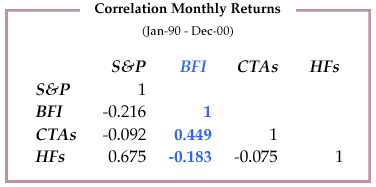
The Hedge Fund Litmus Test
In order to measure the BFI's potential as an effective portfolio diversifier, its performance was examined in a number of ways. For example, during the period of March 1990 through December 2000, whenever the 3-month rolling returns to the
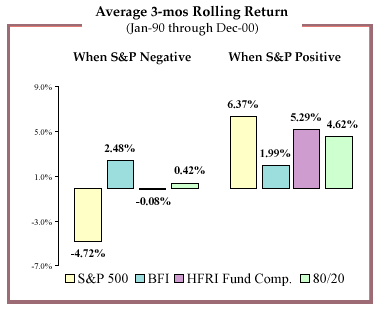
S&P 500 were negative, hedge funds, on average, also declined. The BFI, however demonstrated its value during down periods for the S&P, returning on average 2.48%, and yielding 1.99% during positive periods for the S&P. A portfolio composition of 80% hedge funds and 20% BFI reduced the downside performance to near zero, and returned 4.62% when the market was strong.
For portfolio managers, the only thing more unpleasant than reporting a period of negative performance is reporting consecutive periods of negative performance. Examined on a long-term performance basis over a 10-year period, the BFI demonstrated its ability to reduce the number of consecutive periods of negative returns, when integrated as a 20% weighting within a multi-fund portfolio.
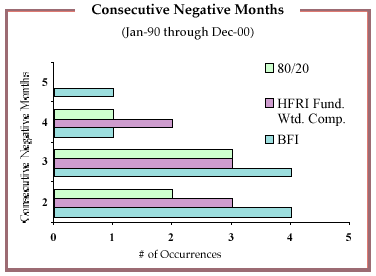
In this study, the BFI also demonstrated its ability to add significant downside protection, by reducing both the percentage of negative quarters as well as the average and maximum negative return, when compared with hedge funds alone. A 10-year comparison of 3-month rolling returns clearly illustrates the benefits of the BFI, compared with average CTA performance. More importantly for portfolio managers, it illustrates the benefits of a 20% BFI weighting within a multi-fund portfolio - in terms of the BFI's ability to provide an effective protection during negative hedge fund performance periods.
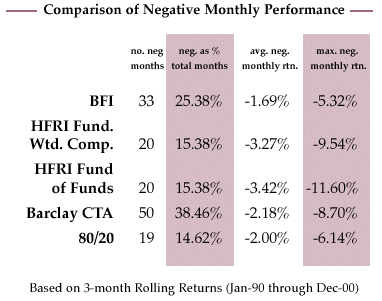
The addition of a diversification component to a portfolio has the potential to reduce absolute returns. However, when combined with a hedge fund portfolio, the BFI can actually improve risk-adjusted performance. As the charts below illustrate, a 20% BFI weighting reduced standard deviation by 170 basis points per year, and improved the Sharpe Ratio of risk adjusted returns during the 10-year period studied. At the same time, the BFI maintained 96% of the non-diversified portfolio's terminal wealth.
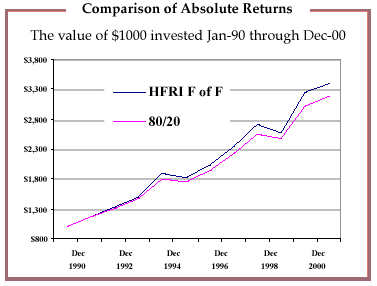
Summary
Although long volatility strategies such as the Barclay Futures Index currently are not widely understood or applied, their lack of correlation with traditional asset classes and most other alternative investment strategies, combined with their favorable risk and return characteristics, are likely to drive investor interest; especially in the current equity market environment.
Based on existing research, a close examination of this strategy is warranted, particularly by portfolio managers who feel they have already achieved maximum diversification and risk reduction by investing in a multi-strategy hedge fund portfolio.


